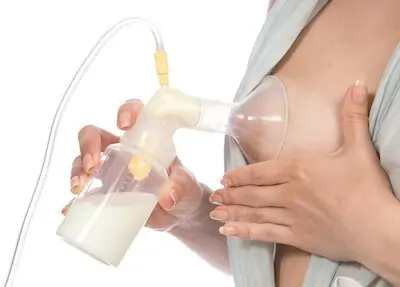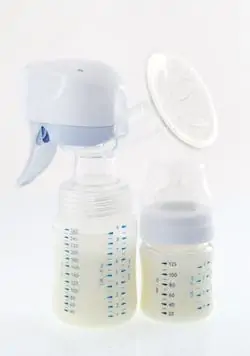For the first four months of my eldest’s lift, I breastfed her while trying to figure out my pump. I’d been offered a teaching position which I didn’t really want to take because I didn’t want to be away from my daughter, but it was excellent income and a really easy, cushy job. My sister-in-law had sent a breast pump over as a gift, a wonderful blessing.
At first, I simply used it to relieve my overly-engorged breasts. I’d tuck that milk away nicely in our freezer for those times when my husband’s parents would come over to spend time with her. But once I was offered the job, I increased my pumping habits because I knew I’d have to have enough breastmilk for her every day while I was at school.
I’d like to say it was an easy thing to do, but it wasn’t in the beginning. Then again, is anything ever really easy? The first few times I tried pumping to get my supply ready for my mother-in-law to feed my daughter, it felt like very little milk was coming out. I found out from La Leche League that there could be many factors for this (I’ll get to that shortly).
For me, I knew one of the biggest reasons was that it wasn’t as comfortable. Was I even doing it right? My breastfeeding coach had come over to make sure I’d assembled everything properly. With her help, I was able to get going but it still seemed like so little was coming out.
I eventually learned to relax and bam!
There was my milk! I’m happy I practiced before starting my teaching job because that was another place I had to get used to pumping. The school was very nice in making sure I had a clean, comfortable place to sit and pump privately but I still felt very awkward. It wasn’t until I got more used to things that my pumping efforts at work were fruitful.
Whether you have to pump because you work full-time (or a frequent flyer due to business meetings) or you want to exclusively pump your milk to feed your baby, this post is for you. Also, even if you just want to go out with your husband without the baby or your baby goes through a nursing strike, you’ll always have breastmilk ready.
Here’s how to be a pumping master!
What’s Normal in Terms of Breastmilk Amounts?
As I’ve mentioned in other posts, it’s important to build your milk supply early on. It’s a supply and demand situation, and when you nurse exclusively those first few weeks, your milk supply will increase naturally.
On the day of birth, your breasts produce around 30 ounces to accommodate baby’s tiny tummy. After 40 days, that amount is around 900ml. Big difference!
Add pumping in this early stage and you might have some issues though. There are a few reasons why:
- Pumps can’t remove milk from the breast quite as well as your hungry, nursing baby. This just means you’re going to have to work harder to get that milk (more on that below).
- It’s stressful when you feel like you’re not pumping enough milk.
- Milk supply will vary at different times of day and over the course of the next weeks, even months.
How much breastmilk should I be able to pump normally?
If you are breastfeeding full-time, you should be able to pump around ½ to 2 ounces. That’s a total from both breasts during each pumping session. If you have an oversupply, you may see more than that. As you get used to pumping, this output increases. You’ll likely notice you need to pump 2 to 3 times to get enough for one feeding. This, my friends, is normal.
It may seem slow-going, but I promise you, it does get easier so don’t fret. When you breastfeed full-time, you may find it’s easier to get that milk because it’s considered extra milk from what your baby needs. But it doesn’t happen for everyone and I speak from experience.
Additionally, you should know that once your milk supply regulates, pumping output could decrease. It’s also very normal for that output to vary on the same day as well as day by day. So, wackiness with breastmilk output? Totally normal!
Oh, and don’t forget growth spurts. Those are normal too. Babies go through several growth spurts in the first year which last about 48 to 72 hours. During this time, your baby will be like a ravenous monster (but a cute one!) that suddenly starts consuming even more breastmilk.
Don’t forget that menstruation, as well as ovulation, can make your milk supply go out of whack. Those crazy hormones are at it again!
All of it is normal, but please do yourself a favor and remember that the amount of breastmilk you draw from your pump is not an accurate measure of the milk that is available in your breast!
Things That Cause Decreased Pumping Output
Before I detail what could be contributing to a decrease in pumped milk supply, I’d like to tell you about how my mother-in-law would overfeed my eldest in the early days. I’d come home with my pumped milk from school and want to nurse my baby. She’d eat a bit but not as much as I’d have liked, which made me pull out the pump.

Then we found out why.
My mother-in-law was using these bottles she’d brought when I specifically asked her to use the controlled flow ones my parents had sent from America. When we explained to her what was going on, she quickly agreed to use the slow-flow bottles. That solved the problem. After that, my eldest was a boobie monster as soon as I came home every day.
Sometimes though, mother-in-law interference aside, it could be something else. Here’s some stuff to watch out for.
Take a look at your pump
A new pump shouldn’t be having problems, but are you sure you have all the parts properly in place? If yours is older, perhaps the motor isn’t as strong as it once was. Running on batteries? Maybe those need to be replaced.
Try a larger flange
Maybe the problem is your pump is uncomfortable for you. You can replace the pump flange and see if that works.
Turn down the suction
The highest suction level isn’t always the best one. In fact, going too high can cause pain and then make it harder for you to pump or nurse. Take it easy!
Less time nursing/pumping
Cutting down on time spent nursing, pumping, or both naturally reduce your milk supply. One missed session here and there doesn’t matter, but you need to keep consistent with your pumping and feeding sessions to keep thing flowing.
Perhaps it’s baby’s love of solids
At 6 months and beyond, when your baby can sit up, solid foods come into play. They should start being more a part of your baby’s diet as he gets older. Your milk supply will naturally decrease the more he turns to food over breastmilk. Unless you have daughters like mine. Then they will eat their solids AND want more breastmilk!
See your doctor about hormones
Sometimes, you can really blame those hormones. When your period comes or you are ovulating, this can cause a decrease. Another thing…pregnancy. You’re not pregnant again, are you? Remember, you can get pregnant again even before you have your first period after having a baby so unless you want another one that quickly, be careful!
Not taking care of you
Hey Gorgeous! Remember you? If you’re putting your health on the back-burner for the sake of the baby, just stop. You need to be eating enough healthful calories and getting what you need. Without the right amount of calories and staying hydrated, it can be a huge factor in the supply of your breastmilk.
And sleep! Oh, hahaha! I know sleep is now this fleeting thing, but try getting more of it when you can. Have your husband watch the baby while you nap, call your parents or your in-laws, call a friend. Just get that sleep in and you might just see that’s all it takes to make your milk flow freely again.
Ways to Increase Pumped Breastmilk Output
So now you know why this might be going. It’s time to solve the problem…increasing your breastmilk output through pumping! Essentially, it requires you to take more milk from your breasts and do it more often. This will keep less milk from accumulating in there between feedings.
- Increase the frequency

According to Ameda, you should pump 8 to 10 times per 24-hour period if you’re just pumping exclusively. If you’re breastfeeding and pumping, make sure you fill your free time with pumping sessions. Milk tends to flow best in the morning so try pumping then if you can.
When both of mine were babies, I would feed them in the morning and then pump. It always worked for me, but you may have to find your sweet spot in the day where your milk is overflowing.
- Nurse more with baby
You may need your baby’s help on this one. That natural suckling is the best stimulus, even better than that pump, to send the signal to your brain to keep that milk coming.
- Add extra pumping sessions
I would do this quite frequently to ensure I had enough stored milk. I’d pump at home while my girls would nap. I’d also pump on the weekends. And while I’ve never tried it myself, my breastfeeding coach told me you could nurse from one breast and pump on the other breast.
- Go for cluster pumping
To cluster pump, you can nurse your baby and pump (one on each breast) and do this every half hour for several hours at a time.
- Or power pump
Some moms will do a 2 to 3 day-long power pumping session every few weeks to boost their supply. To do it, you basically resign yourself to being a boob slave as often as possible and then pump after every nursing session.
- Make sure you pump long enough
If you want to increase breastmilk supply through pumping, you should be sure you pump for a minimum of 15 minutes. When you see the last drops fall in, keep the pump going for another 2 to 5 minutes.
- Go for a double pump
I was thankful for my single pump but I know a double pump would have sped up my pumping time. Some moms though may be affected in the opposite way in that their milk won’t come out enough, even using a top-tier product.
- Massage it first
Sometimes a little manual stimulation is all you need. The warmth of your hands will help the breasts relax and let down milk.
- Try galactagogues
I’ve talked about galactagogues in another post. Funny word, but very helpful stuff. Some moms swear by eating oatmeal, a notorious galactagogue. Fenugreek and other herbs seem to help too.
- Eat and drink well
More protein, more nutrients, and more water will always help. Get in the habit of keeping a healthy snack and water nearby when you’re nursing or pumping. Your body needs nutrition to keep up all that hard work.
- Find your own chill
At the office, your employer should have a safe space for you to pump. You must be granted privacy and a comfortable, clean place to pump. Not in the bathroom! If you have your own corner office, you can simply lock the door and pump undisturbed. If not, your employer must make acceptable accommodations for you.
Even the best rooms for pumping in offices around the globe lack personality though. They may give you a great chair and a private space that allows you to breathe easily, knowing none of your coworkers will burst through the door. But where’s the love? I would always bring photos of my girls when I was pumping. Seeing their little baby smiles made it so much easier to pump.
- Relax
Even at home sometimes, I had a hard time pumping because I couldn’t relax. I started putting on old Pink Floyd and other things that made me feel at ease. I’d look at pictures of my daughters, or I’d read emails from friends I missed back home, and other positive things. I found when I was able to relax, if I wasn’t careful, my cup was running over!
- Try a hands-free pumping bra
Oh, how I wished I had one of these! My friend Chrissy told me all about hers. At her big-time advertising job, she was the boss and she would sit in her office and multi-task through all of the things she had to do while pumping hands-free. She said she’d get in her groove and suddenly, she’d realize her bottles were filled to the brim.
You can make your own with a sports bra if you’re crafty like my friend Angie. She cut holes for the flanges and duct taped them to seal it. Worked for her!
- Make sure you get a good pump
While mine was a gift, if you’re buying your own pump, choose a quality one. You’ll be using it for a while. Especially if you plan on having more children. Most of them come with various flanges to get your perfect fit. Don’t be afraid to go to a baby store and look at your options first too.
There are handheld manual pumps but I advise against them. It can be time- consuming, and it’s so much easier to go electric.
Bottom Line
You need to keep pumping and nursing to keep that milk supply up. If you’re just pumping, be ready to work for it. It’s not impossible, just harder. Keeping up by using these tips will ensure you get the milk you need for your baby.
After using a breast pump for a few weeks, it will get more comfortable and easier to use. My favorite bit of advice on here for you is to just relax. We get so wound up about our kids and everything we have to do. Take those moments when you’re nursing or pumping, play some cool music, and just enjoy the existence.
Leslie Berry lives with her husband and two young daughters in Los Altos, California, where she loves helping other moms get comfortable with motherhood and embracing the insanity with facts peppered with laughs.
She loves eating too much sushi, exercising, and jamming out on her Fender. Read more about Leslie here.







